Leadership
- A/Prof Michael Ponsford
- Prof John Olver AM
- Dr Sean Jepersen
- Dr Brinda Thirugnanam
- Dr Nathan Johns
- Dr Tom Hale
- A/Prof Michael Vagg
- Dr Stephen de Graaff
- Prof Paul Fitzgerald
Highlights
The Epworth Monash Rehabilitation Medicine Unit focuses on conducting innovative research on outcomes following injuries requiring rehabilitation. Led by Professor John Olver, research includes:
- Measuring the nature of sleep of patients in the acute stages following traumatic brain injury
- Monitoring the long-term outcomes of patients post stroke
EMReM also regularly audits primary indicators of rehabilitation outcome.
Our performance
Rehabilitation
Length of stay in rehabilitation and functional independence are two outcome measures employed by Epworth Rehabilitation. These measures are compared to Australia-wide benchmarks provided by the Australasian Rehabilitation Outcomes Centre (AROC) which compare the performance of Epworth Rehabilitation against other private and public rehabilitation facilities. The graphs below display Epworth Rehabilitation’s length of stay and functional independence between 2018 – 2023 against the AROC benchmark for the following patient groups: - brain injury, stroke, re-conditioning, pain and multi-trauma orthopaedics.
Functional Independence Measure (FIM)
The Functional Independence Measure (FIM) is a standardized, commonly used tool which measures a patient's functional status (their ability to perform daily activities) during their inpatient admission. The FIM consists of 18 items and measures various physical and thinking functions such as: mobility, stair-climbing, self-care, eating, transfers, memory and social interaction.
calculate the difference in the FIM scores which represents the improvement of activity in rehabilitation. FIM efficiency measures FIM gains divided by length of stay. The following graphs display that Epworth Rehabilitation is achieving higher FIM efficiency compared to the benchmark across the patient groups.
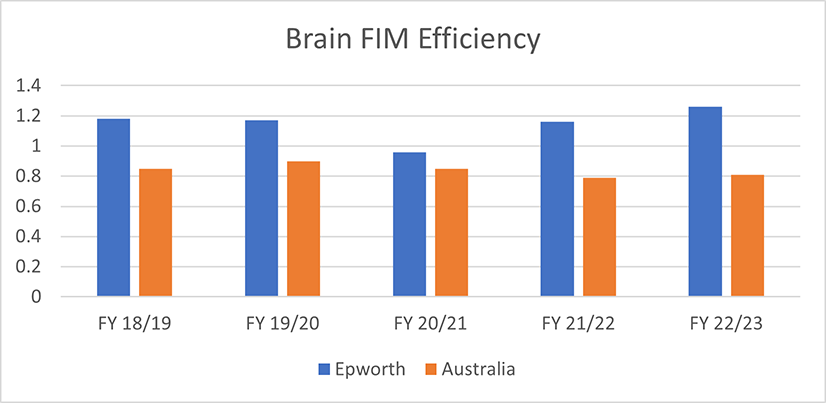
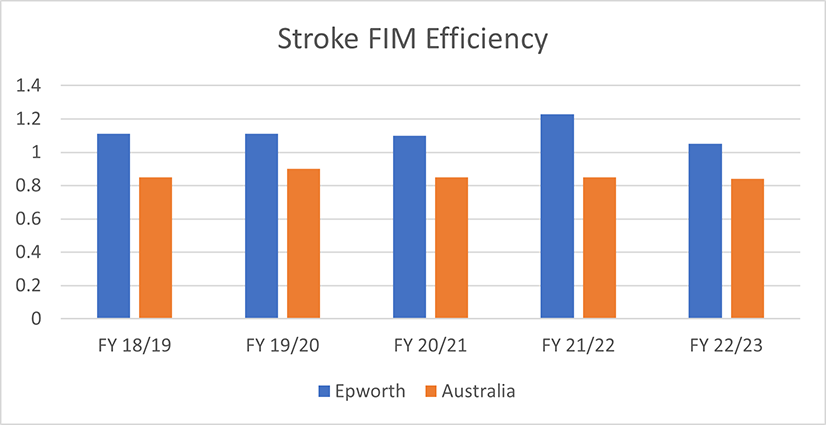
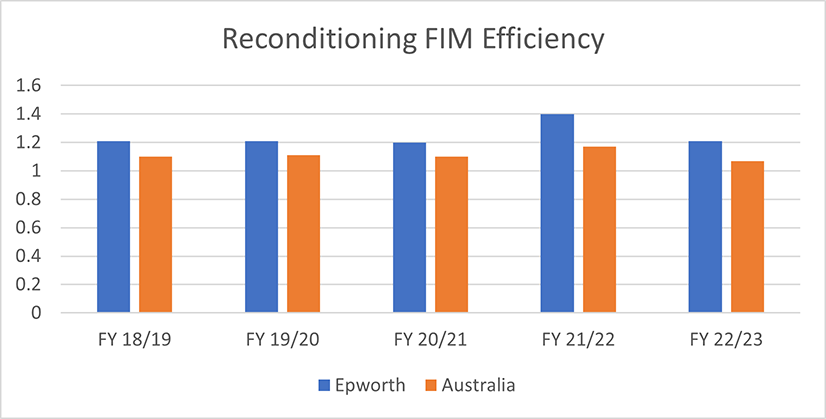
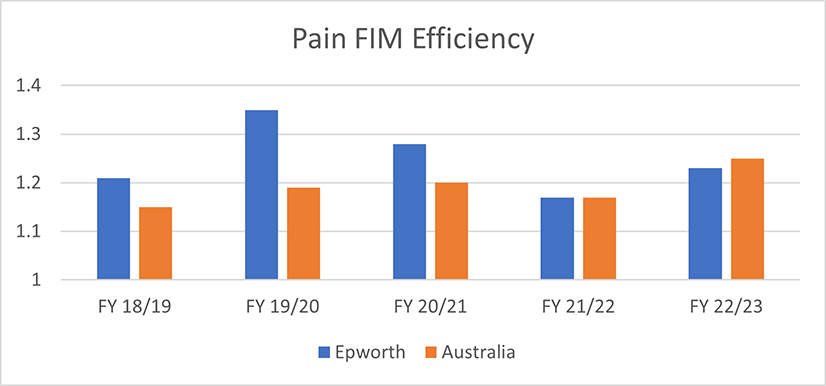
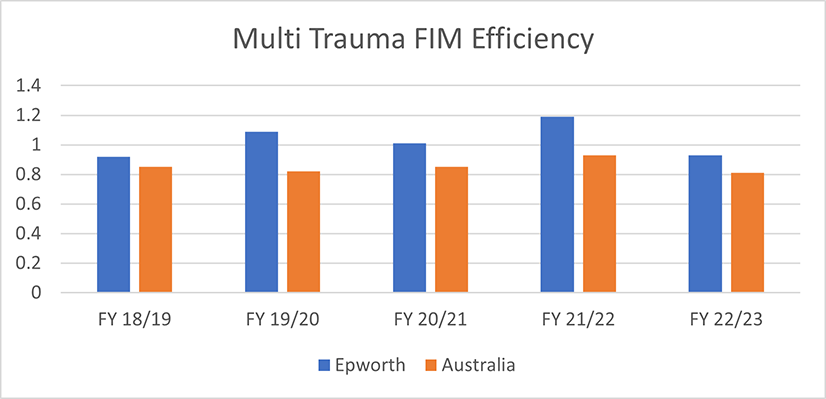
Overall, these graphs suggests that Epworth HealthCare achieves earlier reintegration to patients’ lifestyle without compromising outcome. This allows patients to continue their recovery in the comfort of their own home where Epworth Rehabilitation may provide ongoing support and care, as needed.
Length of stay
Length of stay in rehabilitation and functional independence are two outcome measures employed by Epworth Rehabilitation. These measures are compared to Australia-wide benchmarks provided by the Australasian Rehabilitation Outcomes Centre (AROC) which compare the performance of Epworth Rehabilitation against other private and public rehabilitation facilities. The graphs below display Epworth Rehabilitation’s length of stay and functional independence between 2018 – 2023 against the AROC benchmark for the following patient groups: - brain injury, stroke, re-conditioning, pain and multi-trauma orthopaedics.
Brain injury
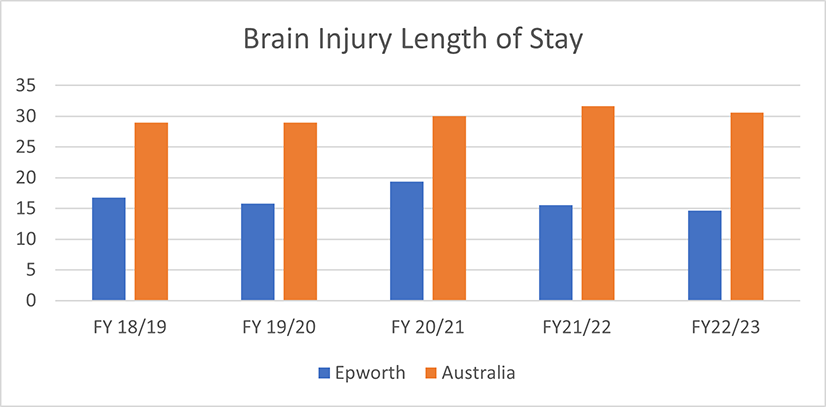
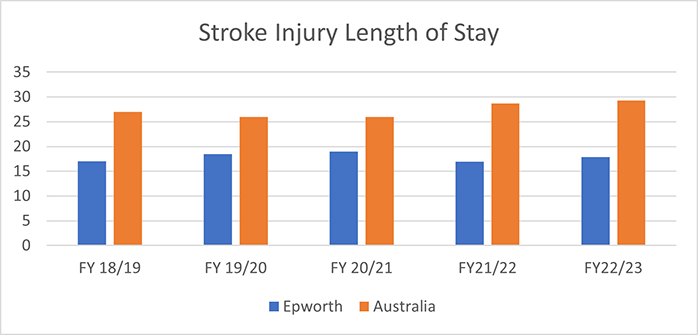
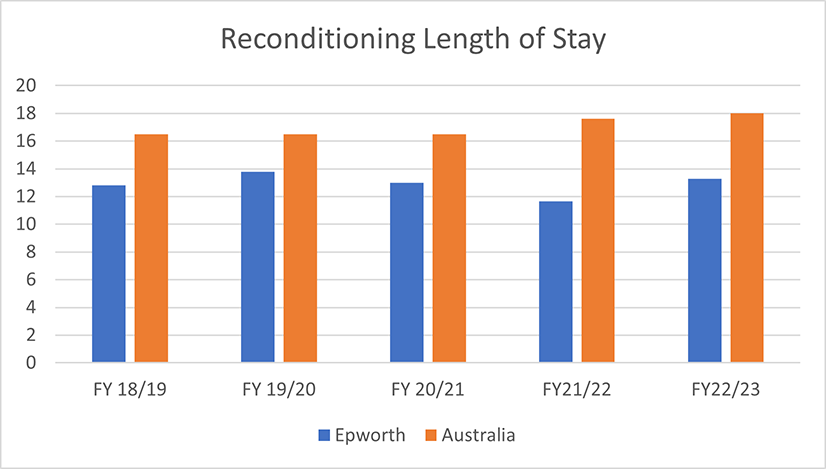

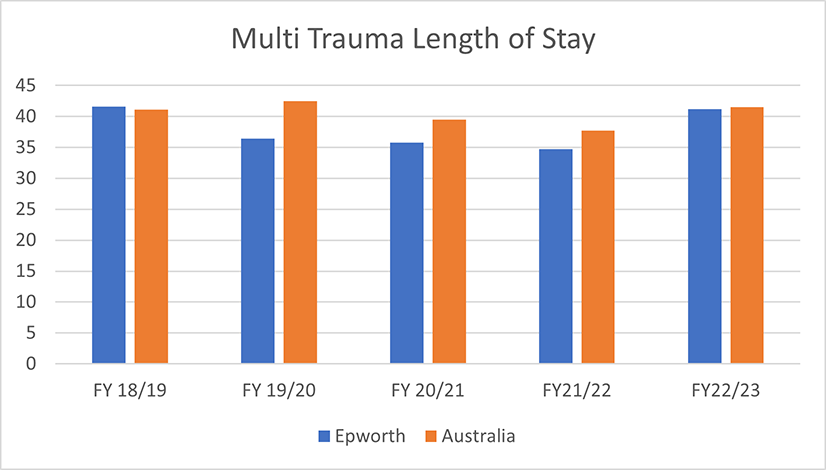
Mental Health
Epworth has approximately 4000 admissions to mental health services per year.
Monitoring of the effectiveness of the service is undertaken via participation in a National benchmarking group.
Key measures of effectiveness are outcomes of care. There are two streams demonstrating both clinician and patient perspectives. These two measures (HoNOS and MHQ-14) indicate the change in patients’ wellbeing from both patient and clinician perspectives:
- HoNOS is a clinician rating of change in behaviour, impairment, symptoms and social functioning.
- MHQ-14 is the patients’ rating of change in disability and distress associated with mental and behavioural problems and disorders. It includes fatigue, anxiety and depression and the impact of those symptoms on social and role functioning.
These ratings are used internationally to measure the degree of change in a patient’s wellbeing between admission and discharge.
This change is referred to as Effect size. Improvement in Effect size is categorised as Small, Moderate and Large.
Epworth consistently scores in the Large change category for Effect size. This means that both clinicians and, critically, patients rate improvement across the patients’ stay as having a significant improvement.
Supporting these outcome measures is the measure for Patient Reported Experience of Care (PEx). The PEx captures ratings across three domains: safety and privacy, clinical staff and treating psychiatrist.
In the PEx measure, Epworth consistently scores Very Good or Excellent for patient experience. As with the outcome measures reported above, the perception held by patients is critical in determining the effectiveness of the care provided.
By all of the above measures Epworth’s care is rated highly. This reflects the expertise of the caring team and the effectiveness of the treatment programs.
Activity
Condition treated
- Acquired brain injury
- Amputation and limb loss
- Amyotrophic lateral sclerosis (ALS)
- Cardiac events
- Cauda equina syndrome
- Cerebral palsy
- Cerebral tumour
- Chronic pain
- Chronic fatigue
- Cognitive and memory issues
- Fibromyalgia
- Guillain-Barré syndrome
- Hip pain
- Hypoxic brain damage
- Insomnia
- Joint replacement
- Knee arthritis
- Knee ligament injuries
- Multiple Sclerosis
- Muscular dystrophy
- Myopathy
- Neurogenic bladder
- Neurogenic bowel
- Narcolepsy
- Paraplegia
- Parkinson's Disease
- Patellofemoral pain syndrome
- Peripheral nerve problems
- Periodic limb movement disorder
- Plantar fasciitis
- Post polio syndrome
- Running injuries
- Sleep disorders
- Spasticity
- Spinal cord injuries and disorders
- Spinal stenosis
- Spondylolysis/spondylolisthesis
- Shoulder injuries
- Stress fractures
- Stroke
- Torticollis
- Traumatic brain injury
